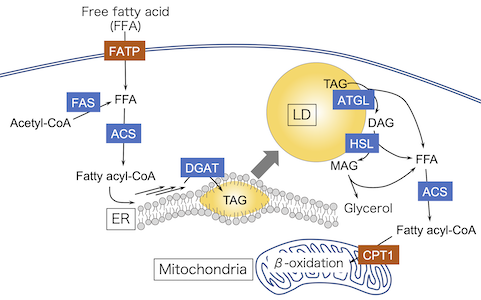Beyond defining the architecture of cells and organelles, lipid membranes regulate key processes such as vesicular trafficking, mechanotransduction, and signal transduction. Emerging evidence highlights membrane contact sites (MCSs) as critical hubs for inter-organelle communication and lipid exchange.
To elucidate the dynamic nature of membrane structures and interactions, we develop sophisticated fluorescent probes capable of analyzing local membrane biophysical properties, which are modulated by the underlying lipid composition. By integrating these chemical tools with advanced fluorescence imaging techniques, we investigate how membrane organization and mechanics are regulated during cellular adaptation, signaling, and organelle coordination.
Proc. Natl. Acad. Sci. USA,116, 15817–15822 (2019).
Angew. Chem. Int. Ed.,63, e202404328 (2024).

Near-infrared (NIR) fluorescence offers distinct advantages for bioimaging, including superior tissue penetration, low phototoxicity, and minimal background signal from autofluorescence. These properties make NIR light particularly well-suited for deep-tissue visualization and long-term imaging in living systems.
To fully leverage the potential of NIR imaging, our laboratory develops high-performance fluorophores that combine strong brightness, photostability, and chemical robustness. We focus on phosphorus-containing xanthene scaffolds, which serve as tunable platforms for achieving desirable photophysical properties in the NIR region.
Building on these dyes, we design functional molecular probes capable of targeting specific biomolecules, such as proteins, lipids, and glycans, or sensing key physiological parameters, including pH, metal ions, and reactive oxygen species. These tools expand the scope of fluorescence imaging in both basic biological research and biomedical applications.
Chem. Sci.,22, 7902–7907 (2021).
Angew. Chem. Int. Ed.,63, e202400711 (2024).

Lipids are essential biomolecules that function as energy reservoirs, structural components of cellular membranes, and precursors of bioactive signaling molecules. Disruptions in lipid metabolism are closely linked to a range of diseases, including obesity, diabetes, and cancer.
To investigate the regulatory mechanisms of lipid homeostasis in living cells, we develop fluorescent probes specifically designed to track lipid species in real time. These include metabolizable fatty acid probes and lipid droplet-targeted dyes that enable visualization of lipid accumulation, degradation, and inter-organelle trafficking, particularly via MCSs. Through these approaches, we aim to uncover how lipid metabolism is regulated under physiological conditions and how its dysregulation contributes to disease pathogenesis.
ACS Mater. Lett.,3, 42–49 (2021).
Nat. Commun.,13, 2533 (2022).

